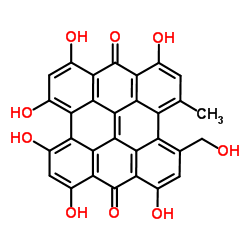Pseudohypericin

Pseudohypericin structure
|
Common Name | Pseudohypericin | ||
|---|---|---|---|---|
| CAS Number | 55954-61-5 | Molecular Weight | 520.443 | |
| Density | 2.0±0.1 g/cm3 | Boiling Point | 994.7±65.0 °C at 760 mmHg | |
| Molecular Formula | C30H16O9 | Melting Point | N/A | |
| MSDS | Chinese USA | Flash Point | 569.2±30.8 °C | |
| Symbol |

GHS07 |
Signal Word | Warning | |
|
Hypericum perforatum: pharmacokinetic, mechanism of action, tolerability, and clinical drug-drug interactions.
Phytother Res. 28(5) , 643-55, (2014) Hypericum perforatum (HP) belongs to the Hypericaceae family and is one of the oldest used and most extensively investigated medicinal herbs. The medicinal form comprises the leaves and flowering tops of which the primary ingredients of interest are naphthodi... |
|
|
The main components of St John's Wort inhibit low-density lipoprotein atherogenic modification: a beneficial "side effect" of an OTC antidepressant drug?
Free Radic. Res. 41(2) , 234-41, (2007) Hypericin and pseudohypericin are polycyclic-phenolic structurally related compounds found in Hypericum perforatum L. (St John's wort). As hypericin has been found to bind to LDL one may assume that it can act as antioxidant of LDL lipid oxidation, a property... |
|
|
Rapid and efficient purification of naphthodianthrones from St. John's wort extract by using liquid-liquid extraction and SEC.
J. Sep. Sci. 32(9) , 1374-82, (2009) Hypericin and pseudohypericin, the main naphthodianthrones present in Hypericum species are among the most promising natural products, but the research concerning their biological activities is hindered by their low content in the plant. In this paper a metho... |
|
|
Variation of hypericins in Hypericum triquetrifolium Turra growing in different locations of Turkey during plant growth.
Nat. Prod. Res. 22(18) , 1597-604, (2008) The principle medicinal secondary metabolites present in Hypericum species are thought to be naphthodianthrones hypericin and pseudohypericin. The present study was conducted to determine ontogenetic and morphogenetic variations of hypericin and pseudohyperic... |
|
|
In vitro photochemical and phototoxicological characterization of major constituents in St. John's Wort (Hypericum perforatum) extracts.
Phytochemistry 72(14-15) , 1814-20, (2011) Extracts from St. John's Wort (SJW: Hypericum perforatum) have been used for the treatment of mild-to-moderate depression. In spite of the high therapeutic potential, orally administered SJW sometimes causes phototoxic skin responses. As such, the present stu... |
|
|
Inhibition of 17β-estradiol activation by CYP1A1: genotype- and regioselective inhibition by St. John's Wort and several natural polyphenols.
Biochim. Biophys. Acta 1814(1) , 168-74, (2011) Several epidemiological studies associate certain CYP1A1 genotypes, alone or in combination, with an increased risk of estrogen-related cancers. Previously we demonstrated that metabolic activation of estrogens by CYP1A1 is a genotype-dependent reaction with ... |
|
|
Pseudohypericin and hyperforin in Hypericum perforatum from Northern Turkey: variation among populations, plant parts and phenological stages.
J. Integr. Plant Biol. 50(5) , 575-80, (2008) Hypericum perforatum is a perennial medicinal plant known as "St. John's wort" in Western Europe and has been used in the treatment of several diseases for centuries. In the present study, morphologic, phenologic and population variability in pseudohypericin ... |
|
|
Antiinflammatory and antioxidant activity of Hypericum rumeliacum Boiss. subsp. apollinis (Boiss. & Heldr.) Robson & Strid methanol extract.
Phytother Res. 22(6) , 766-71, (2008) Plants of the genus Hypericum are widely used in folk medicine for the treatment of gastric ailments (including pectic ulcers), burns, swelling, inflammation, anxiety, as well as for bacterial and viral infections. The aerial parts of Hypericum rumeliacum Boi... |
|
|
Chemical constituents of Hypericum adenotrichum Spach, an endemic Turkish species.
Nat. Prod. Res. 23(13) , 1189-95, (2009) The present study was conducted out to determine hyperforin, hypericin, pseudohypericin, chlorogenic acid, rutin, hyperoside, quercitrin, quercetin, kaempferol, apigenin-7-O-glucoside and amentoflavone contents of Hypericum adenotrichum, an endemic plant spec... |
|
|
Flavonoid glycosides and naphthodianthrones in the sawfly Tenthredo zonula and its host-plants, Hypericum perforatum and H. hirsutum.
J. Chem. Ecol. 37(9) , 943-52, (2011) Larvae of the sawfly Tenthredo zonula are specialized on Hypericum. Whether the sawfly is able to sequester plant metabolites was unknown. Aerial materials of Hypericum perforatum and H. hirsutum, as well as dissected larvae and prepupae of T. zonula, were an... |